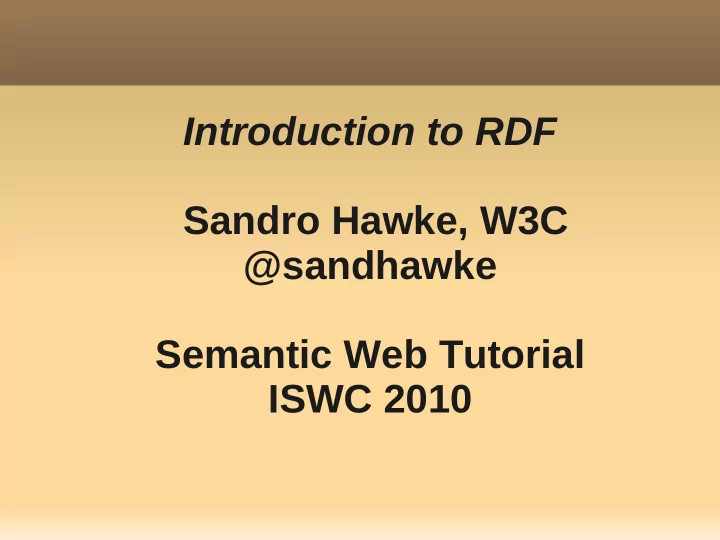

Introduction to RDF Sandro Hawke, W3C @sandhawke Semantic Web Tutorial ISWC 2010
Overview Background Model RDF Graphs and Triples Schema RDF Vocabularies Syntaxes Turtle, RDF/XML, RDFa Sparql
History Remember the Web in the 1990s? Search was hard Content labelling seemed important Maybe Web page metadata could help? Wanted to support all possible metadata Page author, creator, publisher, editor, … And what about them? Email? Job? Phone? Metadata=Data, so RDF=General Data Format
Background: URL We all know basic Web Addresses http://google.com http://www.w3.org/People/Sandro https://gmail.com URL = Web Address of an Information Resource (Web page, image, zip file, …)
Background: URIs and IRIs URI = Looks the same, but might identify something else (person, place, concept) Every URL is also a URI Not everyone agrees with this usage IRI = Like URI, but not just ASCII chars Every IRI can be turned into a URI (%-encoding) Many of us use the term URI when we mean IRI
Background: QNames Used in RDF as shorthand for long URIs If prefix “foo” is bound to http://example.com/ Then foo:bar expands to http://example.com/bar Necessary to fit any example on a page! Simple string concatenation Not quite the same as XML namespaces Mostly the same as CURIEs
Simple, General Representation Pick some entity as your subject List its attributes and values … and its relations to other objects Example subject: the City of Boston Nickname: “Beantown” Population: 642,109 In what state? Massachusetts
Unambiguous Names How many things are named “Boston”? How about “Riverside”? So, we use URIs. Instead of “Boston”: http://dbpedia.org/resource/Boston QName: db:Boston And instead of “nickname” we use: http://example.org/terms/nickname QName: dbo:nickname
Subject Predicate Object (Property) (Value)
RDF “Literals” Data values Often shown inside a rectangle in graph pictures Plain Literals Just strings, “Hello, World” Language-Tagged Literals “Bonjour, Monde”@fr XML Schema Types “3.14”^^xs:float
Nodes with URI Labels If the thing represented by the node has a URI, use it as a label for the node. We often just write qnames Put URIs in <brackets> to distinguish them <http://www.w3.org> ns:created “1994-04-15”^^xsd:date. <http://www.w3.org/People/Sandro/data#Sandro_Hawke> foaf:firstName “Sandro”.
Blank Nodes Nodes with no URI, also called “bnodes” For when you don't have a URI for something … and don't want to create one In N-Triples: ns1:sandro foaf:knows _:node1. _:node1 foaf:name “Dan Brickley”. _:node1 foaf:mbox <mailto:danbri@danbri.org>.
Properties The “Predicate” or “Property” Attribute, Relation Always named with a URI Same URI can be used as Subject or Object This allows self-description, documentation
Classes and rdf:type Sometimes it's helpful to organize using types We can attach types using “type” arcs … and then use those in lots of ways, later
A Little RDF Schema X rdfs:subclassOf Y Everything of type X is also of type Y Dog rdfs:subclassOf Animal, Spot rdf:type Dog |= Spot rdf:type Animal X rdfs:domain Y Everything that has an X property is of type Y ownsPet rdfs:domain Human, Sam ownsPet Spot |= Sam rdf:type Human X rdfs:range Y Every value of an X property is of type Y OwnsPet rdfs:range Animal, Sam ownsPet Spot |= Spot rdf:type Animal
Vocabularies Often formalized with Schemas or Ontologies RDF, RDF Schema rdf:type, rdfs:subClassOf, rdfs:comment Friend of a Friend foaf:name Dublin Core dc:creator, dcterms:temporal Good Relations gr:ProduceOrServiceModel, ...
Turtle Very simple RDF Syntax N-Triple plus a few bits of syntax sugar De facto standard now Widely implement Should be W3C Recommendation soonish db:Boston dbo:nickname “Beantown”; dbo:population “610000”^^xs:integer; dbo:inState db:Massachusetts. db:Massachusetts ...
RDF/XML W3C Standard since 1999, revised in 2004 Used to be the only standard Can look like “normal” XML, but works differently
RDF/XML <rdf:RDF> <Description rdf:about=” http://dbpedia.org/resource/Boston ”> <nickname>Beantown</nickname> </Description> </rdf:RDF>
RDF/XML <rdf:RDF> <Description rdf:about=” http://dbpedia.org/resource/Boston ”> <nickname>Beantown</nickname> <population rdf:datatype=”xs:integer”>610104</dbo:population> </Description> </rdf:RDF>
RDF/XML <rdf:RDF> <Description rdf:about=” http://dbpedia.org/resource/Boston ”> <nickname>Beantown</nickname> <population rdf:datatype=”xs:integer”>610104</dbo:population> <inState> <Description rdf:about=” http://dbpedia.org/resource/Massachusetts ”> <nickname>The Bay State</nickname> .... </Description> </inState> </Description> </rdf:RDF>
RDFa RDF triples in XHTML a ttributes W3C Recommendation 2008 RDFa 1.1 underway Build easily on existing HTML pipeline In some case, just means adding a few attributes
RDFa Example <div about=” http://dbpedia.org/resource/Boston ” xmlns:dbo=”http://example.com/dbo/”> Boston has the nickname <span property=”dbo:nickname”>Beantown</span> </div>
RDFa Example <div about=” http://dbpedia.org/resource/Boston ” xmlns:dbo=”http://example.com/dbo/”> Boston has the nickname <span property=”dbo:nickname”>Beantown</span> and a population of <span property=”dbo:population datatype=”xs:integer”>642109</span>. </div>
RDFa Example <div about=” http://dbpedia.org/resource/Boston ” xmlns:dbo=”http://example.com/dbo/”> Boston has the nickname <span property=”dbo:nickname”>Beantown</span> and a population of <span property=”dbo:population datatype=”xs:integer”>642109</span>. It is located in <a rel=”dbo:inState” href=” http://dbpedia.org/resource/Massachusetts ”> Massachusetts </a> </div>
RDFa Example <div about=” http://dbpedia.org/resource/Boston ” xmlns:dbo=”http://example.com/dbo/”> Boston has the nickname <span property=”dbo:nickname”>Beantown</span> and a population of <span property=”dbo:population datatype=”xs:integer”>642109</span>. It is located in <a rel=”dbo:inState” href=” http://dbpedia.org/resource/Massachusetts ”>Massachusetts</a> Which has <div about=” http://dbpedia.org/resource/Massachusetts ”> the nickname <span property=”dbo:nickname”>The Bay State</span> .... </div> </div>
SPARQL Language for querying collection of RDF Graphs Somewhat like SQL W3C Recommendation in 2008 V1.1 will add update, be more expressive PREFIX foaf: <http://xmlns.com/foaf/0.1/> SELECT ?name ?mbox WHERE { ?x foaf:name ?name . ?x foaf:mbox ?mbox }
Summary of Model RDF started as metadata It's a general data format, a simple KR A collection of RDF knowledge is A graph of subject/object nodes and property arcs Nodes may be labeled with URIs, or Blank Leaf nodes may be literals, optionally typed Vocabularies (Ontologies) Classes, Properties, Individuals Each with a well-known URI
Summary of Syntaxes An RDF Graph can be serialized many ways Turtle (N-Triples, N3) very simple, a de facto standard RDF/XML is the original standard. It's XML, but has some impedance mismatch with XML tools RDFa is good for RDF in HTML Other syntaxes exist, might be standardized Eg JSON RDF can also be accessed via APIs and SPARQL
More Information Me: Sandro Hawke, sandro@w3.org @sandhawke on twitter Semantic Web / RDF http://www.w3.org/standards/semanticweb/ http://www.w3.org/RDF/ This Talk http://www.w3.org/2010/Talks/1107-rdf-sandro
Recommend
More recommend